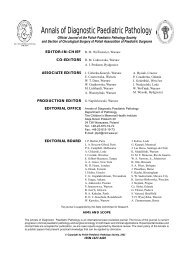annals 1-2.qxd - Centrum Zdrowia Dziecka
annals 1-2.qxd - Centrum Zdrowia Dziecka
annals 1-2.qxd - Centrum Zdrowia Dziecka
You also want an ePaper? Increase the reach of your titles
YUMPU automatically turns print PDFs into web optimized ePapers that Google loves.
9<br />
Table 1<br />
Nongastrointestinal symptoms of celiac disease<br />
Iron and folic acid anaemia<br />
Short stature<br />
Pubertal delay<br />
Unexplained infertility, spontaneous abortions<br />
Epilepsy with intracranial calcifications<br />
Cerebellar ataxia<br />
Depression, irrtability<br />
Osteopenia /osteoporosis<br />
Arthritis<br />
Dental enemal hypoplasia<br />
Recurrent oral ulcers<br />
Unexplained hypertransaminaesemia<br />
Dermatitis herpetiformis<br />
The most common non-gastrointestinal manifestation<br />
of CD, especially in adults is iron and folic acid anemia.<br />
About 11% of adults with anemia resistant to oral iron or folate<br />
supplementation have CD [3, 41]. When patients represent<br />
unexplained iron deficiency anemia the frequency is lower<br />
ranging up to 8%. In children, short stature is the most<br />
common non-gastrointestinal symptom of CD. The incidence<br />
of CD in this group is 8–10% [56].<br />
Numerous studies confirm that disturbances in bone<br />
mineral density are often symptoms in celiac patients. Osteoporosis<br />
is one of the well-known complications of untreated<br />
CD [28, 44]. A GFD in children reverses bone density abnormalities<br />
and the beneficial effects of gluten withdrawal are<br />
persistent [42]. Contrary to pediatric cases, in adults affected<br />
by osteoporosis, a GFD does not reduce the risk of fractures<br />
[57]. In children dental enamel hypoplasia of permanent teeth<br />
could be a single manifestation of CD [1].<br />
A number of neurological and psychological manifestations,<br />
including epilepsy with intracranial calcifications,<br />
primary ataxia, autism, depression, headaches, have been reported<br />
in patients with CD, but the evidence for their association<br />
with CD in children is weak [65]. Our studies on frequency<br />
of CD at risk group of children did not confirm occurrence<br />
of CD in children with epilepsy and autism [4].<br />
There is some evidence for unexplained hypertransaminaesemia<br />
in untreated patients with CD. Up to 9% of<br />
adults with elevated serum transaminases present CD [61].<br />
In biopsies of liver obtained from these patients only nonspecific<br />
inflammatory changes were found, and tle level of enzymes<br />
appeared to normalize on a GFD [61]. Sjogren et al.<br />
found a nonspecific increase of anti-gliadin antibodies<br />
(AGA) in a numbers of liver diseases, such as alcoholic cirrhosis<br />
(20%), primary biliary cirrhosis (16%), primary sclerosing<br />
cholangitis (24%), hepatitis HCV (11%) [52]. However,<br />
the evidence of an increase of CD confirmed by histo-<br />
logical lesions was found only in patients with autoimmune<br />
hepatitis [59].<br />
Unexplained infertility could be also a syndrome of<br />
atypical CD [29]. Incidences of menstrual irregularities and<br />
spontaneous abortions appear more often in women with CD<br />
than in general populations [29]. In children with CD pubertal<br />
delay can occur.<br />
Other atypical syndromes of CD are recurrent oral<br />
ulcers and arthritis. Up to 3% of children with juvenile arthritis<br />
present CD [54].<br />
Nowadays, dermatitis herpetiformis is considered to<br />
be a cutaneous manifestation of gluten sensitivity [27]. Dermatitis<br />
herpetiformis is a severe itchy, blistering skin disease<br />
with abnormalities occurring on the elbows, knees and buttocks.<br />
In intestinal biopsy typical for CD histological lesions<br />
are found. The treatment with a GFD approves skin and intestinal<br />
abnormalities.<br />
Associated conditions<br />
CD is associated with a number of autoimmune and non autoagressive<br />
genetical diseases (Table 2). Autoimmune disorders<br />
occur ten times more frequently in adult patients with<br />
CD than in general populations. Up to 8% of patients with<br />
type 1 diabetes have the characteristic features of CD in<br />
small intestinal biopsy [8, 48]. This figure may be an underestimate,<br />
as serial screening of individuals with type 1 diabetes<br />
over a period of years has identified additional cases<br />
who initially had negative serological tests [8]. CD is also<br />
more often recognize in patients with autoimmune thyroiditis<br />
[54, 61], Sjogren's syndrome [35], cardiomyopathy [47],<br />
autoimmune myocarditis [18] and in autoagressive endocrynological<br />
disorders [45].<br />
The incidence of CD in individuals with Down syndrome<br />
is between 5% and 12% [20]. About one third of patients<br />
present atypical non-gastrointestinal syndromes. An increased<br />
prevalence of CD, which ranges from 4,1 to 8,1%<br />
Table 2<br />
Diseases associated with celiac disease<br />
Disease<br />
Percentage of association<br />
Diabetes mellitus type 1 1 5–8%<br />
Autoimmune thyroitidis 4–5%<br />
Sjogren’s syndrome 5%<br />
Autoimmune hepatitis 6,4%<br />
Juvenile arthritidis 6,6%<br />
Addison’s disease 7,9%<br />
Cardiomyopathies 2,1–5,76%<br />
Autoimmune myocarditis 4,4%<br />
Down syndrome 5–12%<br />
Turner syndrome 4–8%<br />
Wiliams syndrome 8,2%<br />
Selective IgA deficiency 2–8%

















